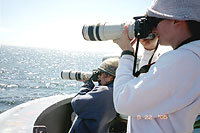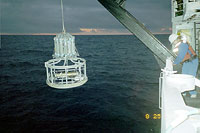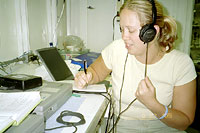

 | |||||||
|
|
Journals 2005/2006Maureen Barrett
August 25, 2005 Even though we were off effort most of the day yesterday due to high winds, we did see a couple of fin whales. They surfaced about two hundred meters from the Jordan. Some of the observers were even able to see the asymmetrical coloration of the lower jaw! Chief Scientist Susan Chivers decided to redo yesterday's track since most of the day was spent off effort, and the weather was supposed to improve. However at sunrise, the Beaufort remained a 6, and we could not go on effort. Mammal observations still continue while off effort, but to a lesser degree. One observer remains on the flying bridge to do a "recorder watch." When a marine mammal is sighted, the details of the sighting are recorded and entered into the computer as if we were on effort. However, the data are not used to estimate abundance but are used to document the distribution of cetacean species. Within a few hours, the winds calmed down a bit and put us on effort. It was a quiet few hours until some Baird's beaked whales appeared at a distance, and then a fin whale. But neither hung around very long and were soon lost to the deep blue sea. Three of the mammal observers are responsible for taking photographs of the cetaceans we see. Cornelia, Holly, and Annie use digital cameras that zoom from a range of 300 mm to 400 mm. At the end of each day, the photos are downloaded to the computers in the dry lab. The pictures are important to identify species as well as individuals. The photos taken on board are renamed and labeled with sighting information, the individual's name who took the photo, and each photo is given a quality rating. The Southwest Fisheries Science Center in San Diego is one of the organizations with photo id catalogs for sperm whales and killer whales. Photographs of blue and humpback whales are contributed to photo-id catalogs maintained by other institutions. All of the photos taken are burned to CDs. At the end of each leg, the photographers put together a "best of" CD. I look forward to seeing the best of our cruise and sharing it with my students and colleagues back at Harrington Middle School in Mt. Laurel, New Jersey! The main purpose of this expedition is to conduct a collaborative survey of the cetacean abundance in the Pacific ecosystem (CSCAPE). However, other studies are being conducted on a daily basis. For example, there are two oceanographers on board: Candy Hall and Liz Zele. Candy and Liz are responsible for bongo plankton tows, CTD measurements, and acoustics. The bongo tows are done each night after sunset. The nets are lowered to a depth of 300 meters. After about 20 minutes, samples are collected from the nets and preserved in jars for identification back at the lab in San Diego. The samples help determine concentration estimates of plankton, jellies, larvae, and small fish. The findings may also help the scientists determine predator/prey relationships. Gary (one of the mammal observers) and I had a chance to look at some of the sample using a microscope. We found a nice collection of micro and macroorganisms! The CTD (conductivity temperature depth) is deployed every morning around 5:00 A.M. The CTD provides a temperature conductivity profile from the surface to 1000 meters down and measures conductivity, temperature, and water pressure throughout its cast. The salinity at different depths is calculated by measuring the conductivity of the water, relative to the temperature. There are twelve Niskin bottles on the CTD rosette, and each bottle obtains a sample at a depth determined by the oceanographers. Nutrients, chlorophyll, salts, and primary productivity can all be determined from tests conducted on the water samples. In the end, these data are used to describe the habitat of the different cetacean species we are seeing. Candy and Liz also are in charge of the acoustic recordings. Two different devices are being used on this leg of CSCAPE. The Jordan has a hydrophone mounted on the bow of the ship. A cable leads from the bow hydrophone to the dry lab where the cetacean recordings can be heard and also viewed on a computer screen. The second device is a sonobuoy. This is what was used to record the Baird's beaked whales yesterday. It is a portable hydrophone with an antennae. It gets tossed overboard, and then it inflates to hold the antennae above the sea surface. It can detect sound for up to approximately five miles. The sonobuoys used on the cruise are actually retired Navy equipment that was made to detect submarines. So even though the focus of this trip is to survey cetaceans to estimate abundance, all of the studies being conducted help scientists understand the pelagic ecosystem. |
||||||



